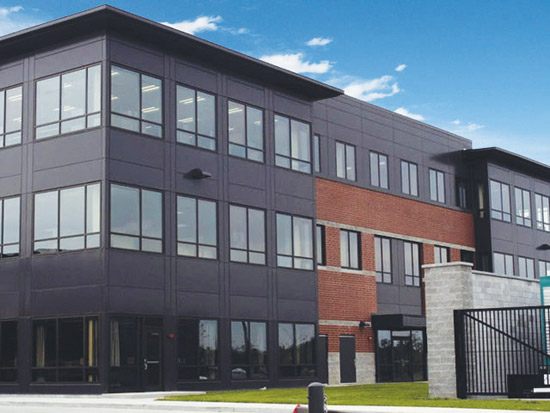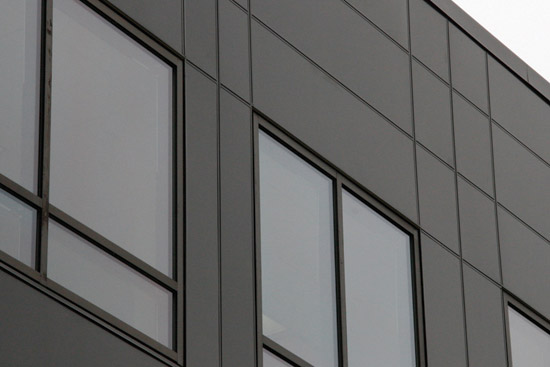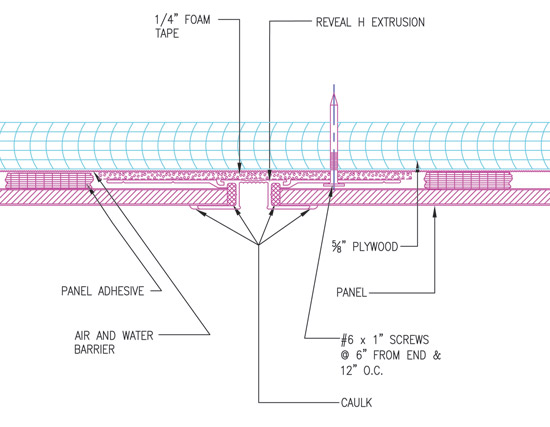Barrier vs. Rainscreen Exteriors
Thermal Expansion
In regions with greater variability in climate conditions (cold or extremely cold winters and hot summers), the façade will see much greater variability in thermal movement, and sealants will tend to fail more quickly. When the temperature is cold, all of the materials on the façade contract and pull away from each other. When they heat up, they expand. With all façade materials, but especially metal panels that readily conduct heat, dimensions change as the material expands and contracts with fluctuations in temperature. This thermal movement must be taken into consideration.
The amount of thermal movement needs to be calculated at the design phase, and the panel dimensions sized to limit the cumulative movement. Otherwise, when panels expand, they will push into each other, causing them to buckle and deform. As panels contract, the joints between panels will open up beyond what the sealant can tolerate.
Thermal expansion is one factor that must be clearly understood when selecting an approach to keep water out of a wall system. In a harsh climate—either very cold or very wet—a barrier system may not be appropriate, regardless of the material. In less severe climates, thermal expansion still needs to be understood and carefully calculated when using metal panel systems. But as long as it is addressed at the design phase, it is completely manageable.
Ultraviolet Radiation
Even when panels are sized correctly to eliminate extreme dimensional changes that would cause these immediate failures, the panels still move back and forth. That's why sealants are flexible. But over time, the sealant dries out and hardens. Ultraviolet light breaks down the sealant chemicals, reducing its ability to absorb thermal movement, causing the sealant to crack and the bond to fail. All caulks, gaskets, and foam tapes are vulnerable to this eventual failure. Some last longer than others but eventually, if the sealant is directly exposed to sunlight, it will deteriorate.
Concealed Joints
With many manufactured systems, the joints are not simple face seals. With many composite metal panel systems, for example, many of the caulk joints are protected from direct exposure to the sun, making the system much more durable over time.
 |
As a government project, the Fort Knox Human Resource Center had to work within a limited budget and meet a minimum LEED Silver design certification. Photo courtesy of Laminators Inc. |
 |
The edges of the composite metal panels used on the Ft. Knox Human Resource Center fit into extrusions (see bottom image), which protect the caulk used to seal the panels. Photo courtesy of Laminators Inc. |
 |
Illustration courtesy of Laminators Inc. |
Typically, panels fit into extrusions or are covered by trim molding. This protects the sealant from exposure to ultraviolet light. This is a key feature. Because the metal panel itself is impervious to moisture, the joint is the only site for water entry. And because this joint is less vulnerable to installation error and the sealants are protected, a metal panel exterior can be a feasible barrier system.
Two Types of Sealant Joints
 |
In this metal panel system, the caulk that seals the panel is protected by the J-extrusion. At the end of a run, however, a conventional face seal is required. Illustration courtesy of Laminators Inc. |
Indeed, it is possible that a barrier system may be the most appropriate option for a given project. There is a widespread belief that barrier systems are inferior in all cases. While it may be less forgiving to installation errors and climate extremes, in many situations a barrier system is the best option. The crucial elements are the cladding material and the seal between cladding members. Manufactured systems, in which the joints between cladding members are better controlled, have the best chances of performing well over time.
Cost effectiveness is a primary reason for choosing a barrier approach. Since a single-plane barrier approach does not require installation of a separate weather barrier or detailing required to create an air space between the cladding and the structure, a barrier system is typically less costly to install. Assuming the project location is not in a severely cold or wet climate, and an impermeable material, such as a composite metal panel system is used, a barrier system may be a very practical solution.
Drainable Assemblies
The success of a drainable assembly largely relies on the integrity of the weather barrier behind the cladding. The weather barrier covering the “inner leaf” of the wall assembly must be shingled, so pieces installed higher on the wall overlap pieces installed lower on the wall. This way, water draining down the surface flows to the outside. In addition, the weather barrier must be flashed at the base and around all wall penetrations, and these flashings integrated “shingle fashion” to ensure that water does not get trapped in the wall.
If the outer cladding is mostly airtight, this outer skin becomes the primary support for wind pressures. That means the air space between the cladding and the structure will be at a lower pressure. This imbalance can create suction pressures that draw wind-driven rain into the cavity, and the amount of water getting drawn in may exceed the ability of the system to drain adequately.









